
The Halls of the Dwarven Kings is an adventure published by Integrated Games in 1984 for any role-playing game system.

The Halls of the Dwarven Kings is an adventure published by Integrated Games in 1984 for any role-playing game system.
The Halls of the Dwarven Kings is an adventure in which the player characters must explore the ruins of a vast dwarven city to find and recover the crown of a dwarven king from ancient times. [1] It is designed to be used with any fantasy role-playing system; suggestions for converting statistics to systems similar to Advanced Dungeons & Dragons and RuneQuest are included.
Integrated Games planned a five-part fantasy role-playing adventure series called The Complete Dungeon Master Series. Between 1984 and 1987, Simon Forrest and Basil Barrett wrote four adventures, the first in 1984 being The Halls of the Dwarven Kings, a boxed set containing a 24-page book, an 8-page pamphlet, a 12-page illustration booklet, a cardstock screen, 12 colour cardstock floor plans, and 4 pages of play aids. [1] Artwork was by Judith Hickling, Jes Goodwin, Jon Baker, Paul Ward, Toby Hardwick, and Selina Goodman.
The sequels that followed were The Lost Shrine of Kasar-Khan , The Watchers of the Sacred Flame , and The Feathered Priests . Integrated Games went out of business before a planned fifth adventure, Deep Water, Shallow Graves, was published.
In 1992, Flame Publications, an imprint of Games Workshop, bought the rights to The Complete Dungeon Master Series, and Simon Forrest, Brad Freeman and Graeme Davis revised all four adventures to conform to the Warhammer Fantasy Roleplay rules, releasing them as the Doomstone Campaign Book Series. The first adventure in the series, The Halls of the Dwarven Kings, was retitled Fire in the Mountains. [1]
In the April 1985 edition of Imagine (Issue 25), Paul Cockburn was impressed by the sheer amount of game material in the box, saying, "no purchaser is likely to be disappointed. This is a lavishly-equipped DM aid." However, Cockburn was disappointed with the adventure, believing that players were encouraged to fight first rather than role-play. He pointed out that "there is an excellent plot going on in the background, which the players can only truly understand through interaction with the NPCs — don't let the fighting start from the first room." He concluded, "This is a good package. If it is not a great scenario, it certainly isn't one of the worst that I've ever run, and with some creative alterations, can be very good." [2]
In the June 1985 edition of White Dwarf (Issue #66), B.Y. Rowe called this adventure "a new concept in gaming: everything for the harassed DM is done, all cross-referenced, reviewed, illustrated and explained." However, Rowe found the 12 pages of illustrations were "not up to normal artwork status." Rowe praised the gamemaster's screen for having an entire keyed floorplan, and said "the real bonuses are the cut-out maps, scrolls and artifacts." Rowe concluded by giving the adventure an above average rating of 8 out of 10, saying, "Halls of the Dwarven Kings is perfect as an illustration of how to set up an adventure; the DM need only read the background and then the characters can begin. This is the first of a new series and promises to be a worthwhile addition to any DM's armoury of adventures." [3]
In the July 1988 edition of Dragon (Issue #135), Ken Rolston called the player handouts "remarkable game aids and props", and noted with approval that "a particularly fine touch is that not all of these handouts are really significant." He also admired the floor plans, calling them "well-designed" and "clearly rendered, not cluttered with illustration-style detail." He also thought the gamemaster screen was "the most useful, detailed and well-designed DM screen I've ever used." Rolston did note that the dungeon was very complex; while he admitted that the result was "pretty spectatcular", he warned that "studying and understanding the Dwarven Halls is no simple matter." He concluded with a strong recommendation for this and the other three adventures in the Complete Dungeon Master Series, saying, "On presentation alone, it qualifies for the FRPG Supplement Hall of Fame. Experienced gamers should love it. Rookies may love it, too, but may find it too complex and sophisticated. Above all, Halls of the Dwarven Kings is unique for the amount of detail and variety of play aids lavished on a single scenario setting." [4]

The Gem and the Staff, by John and Laurie Van De Graaf, is an adventure module for the Dungeons & DragonsExpert Set. Rather than being a typical group adventure, The Gem and the Staff was designed for head-to-head tournament-style play, with players separately playing the same adventure and competing against each other for points earned by accomplishing certain goals. The adventure is only playable with one dungeon master (DM) and one player.
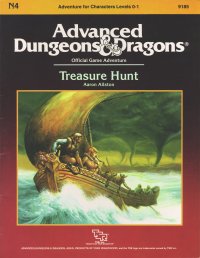
Treasure Hunt is an adventure module for the Advanced Dungeons & Dragons (AD&D) role-playing game, written by Aaron Allston for the 1st edition Advanced Dungeons & Dragons (AD&D) rules. The player characters must evolve into their roles as the adventure progresses, beginning as slaves on a galley who become freed after a shipwreck on an island where orcs and goblins contend over a treasure. The adventure received a positive review from White Dwarf magazine.
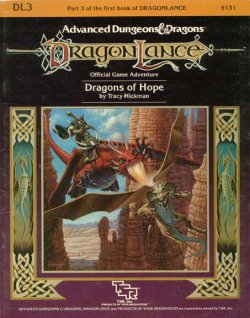
Dragons of Hope is an adventure in the Dungeons & Dragons fantasy role-playing game. It is the third module of the 14 Dragonlance adventures published by TSR, Inc., between 1984 and 1986. The module is intended for level 6-8 player characters.

Dragons of Desolation is the fourth and final module in the first major story arc in the Dungeons & DragonsDragonlance series of game modules. It is one of the fourteen Dragonlance adventures published by TSR between 1984 and 1986. The module is intended for player characters of level 6–8.
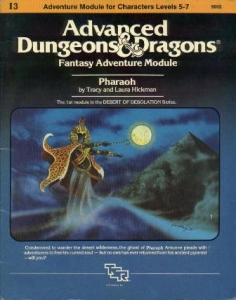
Desert of Desolation is a compilation adventure module published by TSR for the Dungeons & Dragons (D&D) fantasy roleplaying game. It combines three previously published individual modules: Pharaoh, Oasis of the White Palm, and Lost Tomb of Martek. The modules were made for use with the first edition Advanced Dungeons & Dragons (AD&D) rules. Pharaoh was created by Tracy and Laura Hickman soon after the couple married in 1977, and published by TSR in 1982. Oasis of the White Palm was a collaboration between Tracy Hickman and Philip Meyers, and Hickman wrote the Lost Tomb of Martek on his own; both were printed in 1983.

The Veiled Society is an adventure module for the Basic Rules of the Dungeons & Dragons fantasy role-playing game published in 1984. The adventure's product designation is TSR 9086.

Night's Dark Terror is an adventure module for the Dungeons & Dragons (D&D) fantasy role-playing game written by British game designers Jim Bambra, Graeme Morris, and Phil Gallagher. It was designed specifically for campaigns transitioning from the D&D Basic Set to the D&D Expert Set. The player characters (PCs) journey from a farmstead into uncharted wilderness, where they encounter new hazards and contend with a secret society. The adventure received a positive review from White Dwarf magazine.
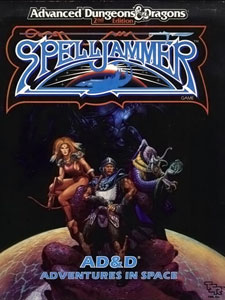
Spelljammer: AD&D Adventures in Space is a 1989 boxed set accessory for the Spelljammer campaign setting, part of the Advanced Dungeons & Dragons (AD&D) fantasy role-playing game. It supplies rules and materials for playing AD&D in space. The set was well received by critics and fans.

The Northern Reaches is an accessory for the Dungeons & Dragons fantasy role-playing game. The book describes the land known as the Northern Reaches, which lie on the eastern seaboard of the D&D game's Known World, also known as Mystara.

A gamemaster's screen, also called a GM's screen, is a gaming accessory, usually made out of either cardboard or card stock, and is used by the gamemaster to hide all the relevant data related to a tabletop role-playing game session from the players in order to not spoil the plot of the story. It also hides any dice rolls made by the gamemaster that players should not see. In addition, screens often have essential tables and information printed on the inside for the gamemaster to easily reference during play.
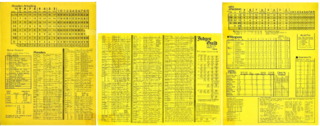
Judge's Shield is a gamemaster's screen created by Judges Guild in 1977 for the fantasy role-playing game Dungeons & Dragons, the first such screen to be published.
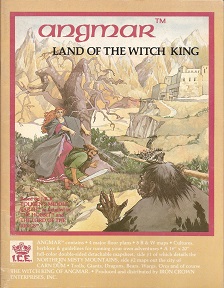
Angmar: Land of the Witch King is a fantasy role-playing sourcebook published by Iron Crown Enterprises (I.C.E.) in 1982 based on J.R.R. Tolkien's The Lord of the Rings trilogy. The book expands upon Tolkien's few brief mentions of Angmar, an evil kingdom, providing gamemasters with enough material to create a setting in which player characters can experience Angmar.

Death in Dunwich is an adventure published by Theatre of the Mind Enterprises in 1983 for the horror role-playing game Call of Cthulhu.
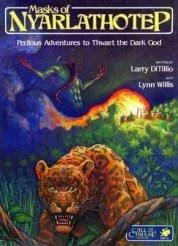
Masks of Nyarlathotep, subtitled Perilous Adventures to Thwart the Dark God, is an adventure campaign first published by Chaosium in 1984 for the second edition of the horror role-playing game Call of Cthulhu. A number of revised editions have subsequently been published. Masks of Nyarlathotep is a series of several sequential adventures set in the 1920s that take the player characters from New York, to London, Cairo, Nairobi, and Shanghai as they deal with the threat of the god Nyarlathotep. Screenwriter Larry DiTillio wrote the adventure with game designer Lynn Willis during a writer's strike. It received positive reviews in game periodicals including Casus Belli, The Space Gamer, White Dwarf, Different Worlds, and Dragon, and is considered to be one of the best roleplaying adventures of all time.

Saga Pack is a supplement published by Lion Rampant in 1990 for the fantasy role-playing game Ars Magica.

The Lost Shrine of Kasar-Khan is an adventure published by Integrated Games in 1985 for fantasy role-playing games.
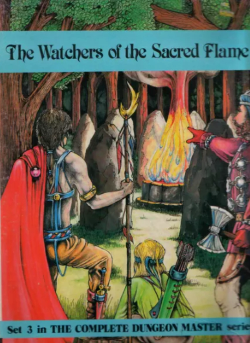
The Watchers of the Sacred Flame is an adventure published by Integrated Games in 1986 for any role-playing game system.

The Feathered Priests is an adventure published by Integrated Games in 1986 for any role-playing game system.

No Honour in Sathporte is an adventure published by Chaotic Intellect Products in 1983 for the fantasy role-playing game Advanced Dungeons & Dragons.

Middle-earth Role Playing Combat Screen is a 1984 fantasy role-playing game supplement published by Iron Crown Enterprises for Middle-earth Role Playing.